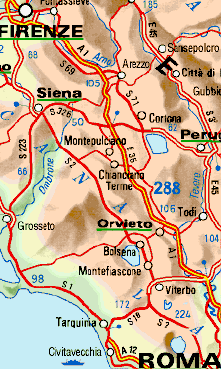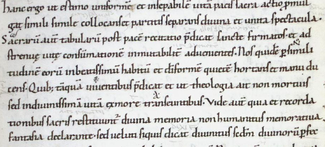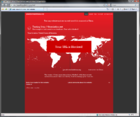Thomistica is 10 years old
/Just a short note to remind our friends that today marks the ten-year anniversary of thomistica.net's first post! Thanks to all for their contributions and support. Ad multos annos, nos omnes!
Just a short note to remind our friends that today marks the ten-year anniversary of thomistica.net's first post! Thanks to all for their contributions and support. Ad multos annos, nos omnes!
Leafing through my family's Jerusalem Bible I found a pamphlet from Lent of 1975 that left me bug-eyed. I was about to turn fourteen years of age, and was a dutiful if unenthused Catholic. Our family went to a Lenten service at church. The rest I'll tell you now.
Read MoreFound a near twenty year-old video clip to illustrate how Thomas's doctrine of the discrete acts of will works. Which act of will is this?
Read MoreMany people know that the Via Cassia is the road on which Hilaire Belloc, somewhere south of the intersection with the Via Trionfale, first caught a glimpse of Rome — this at least according to Belloc’s account of the event in his celebrated travelogue The Path to Rome. As I understand, that was in 1901.
Fewer people — mostly Jesuits and devotees of St. Ignatius of Loyola — know that the founder of the Society of Jesus, who was also on his way to Rome, had a vision on the Via Cassia in which he heard the words “Ego vobis Romae propitius ero” (more or less: “I will be propitious to you in Rome.”). Ignatius interepted the statement thus: “I do not know whether we shall be crucified in Rome, but Jesus will be propitious.” This occurred in the village of La Storta, which is only a little north of where Belloc saw Rome for the first time. A simple chapel now stands in La Storta to commemorate Ignatius’s vision. The vision took place in 1537.
Probably only some grumpy old Aquinas scholars know that the Via Cassia also had an important place in the early life of St. Thomas. He had set out on foot with other Dominicans along the Via Cassia — traveling away from Rome — in 1244 just before Pentecost, heading for a general chapter in Bologna.
 On hearing of this intended journey, Thomas’s mother, who, as is well known, did not want him to be a poor friar, sent his brother Rinaldo, who was camped nearby at Frederick II’s headquarters at Terni (a complex struggle was going on involving Frederick, Innocent IV, and Cardinal Ranieri), to intercept Thomas and bring him home to Roccasecca. This Rinaldo managed to do, meeting Thomas near Acquapendente (around 85 miles north of La Storta). Thus began the infamous episode of Aquinas’s “imprisonment” (probably too strong of a word) by his family, which ended in the Summer of 1245, when he was permitted to return to the Dominicans in Naples.
On hearing of this intended journey, Thomas’s mother, who, as is well known, did not want him to be a poor friar, sent his brother Rinaldo, who was camped nearby at Frederick II’s headquarters at Terni (a complex struggle was going on involving Frederick, Innocent IV, and Cardinal Ranieri), to intercept Thomas and bring him home to Roccasecca. This Rinaldo managed to do, meeting Thomas near Acquapendente (around 85 miles north of La Storta). Thus began the infamous episode of Aquinas’s “imprisonment” (probably too strong of a word) by his family, which ended in the Summer of 1245, when he was permitted to return to the Dominicans in Naples.
On your next trip to Italy you might consider a jaunt on the Via Cassia, Strada Regionale 2 (formerly Strada Statale 2). See the map above. The Cassia is the road marked “S2”. As far as I know, the route of the Cassia has changed very little since the eighth century, maybe a few deviations here and there. So, the stretch of it that you take may very well be the same stretch traveled by Aquinas, Ignatius, and Belloc.
 When my beloved teacher, James A. Weisheipl, OP, wrote his Friar Thomas d’Aquino back in 1974 he contended that Thomas Aquinas’s earliest scripture commentaries were cursory readings on Isaiah, Jeremiah, and Lamentations done while Thomas was with St. Albert the Great in Cologne, in the period 1248-1252. For Weisheipl these early works and their supposed sterilitas doctrinae were not the product of the precocious bachelor of the Sentences doing his work in Paris from 1252-1256, but were better considered the work of a talented young Dominican in St. Albert’s retinue in Cologne, a baccalaureus biblicus—even though no contemporary witness ever said that Thomas lectured on the Bible, even cursorie, while with Albert in Cologne. Besides, as the “dumb ox” (bos mutus) story indicated, Thomas was just too smart to have been with Albert only as a student or even as an—gasp!—assistant.
When my beloved teacher, James A. Weisheipl, OP, wrote his Friar Thomas d’Aquino back in 1974 he contended that Thomas Aquinas’s earliest scripture commentaries were cursory readings on Isaiah, Jeremiah, and Lamentations done while Thomas was with St. Albert the Great in Cologne, in the period 1248-1252. For Weisheipl these early works and their supposed sterilitas doctrinae were not the product of the precocious bachelor of the Sentences doing his work in Paris from 1252-1256, but were better considered the work of a talented young Dominican in St. Albert’s retinue in Cologne, a baccalaureus biblicus—even though no contemporary witness ever said that Thomas lectured on the Bible, even cursorie, while with Albert in Cologne. Besides, as the “dumb ox” (bos mutus) story indicated, Thomas was just too smart to have been with Albert only as a student or even as an—gasp!—assistant.
Or, as Fr Dewan put it to me once, “Fr Weisheipl couldn’t imagine that Thomas was ever Albert’s lackey”!
As it happens, in discoveries made this past decade it is now pretty clear that Thomas was indeed an assistant to St. Albert, doing some legwork so that Albert could have the best text available as he produced his commentaries on the works of Pseudo-Dionysius (a copy of whose Albertine commentaries we have in Thomas’s own autograph). In 2005 Maria Burger published some of the research she conducted as part of the Cologne edition of St. Albert’s works. She found a manuscript from Cologne’s Cathedral church library (Codex 30) that contained an 11th-century copy of the works of Pseudo-Dionysius, running the gamut from the Celestial Hierarchy to the Divine Names. But found in the margins and between the lines of this 11th-century hand were notes written in the telltale littera illegibilis of the young Thomas Aquinas. It turns out that his task had been to compare the Latin text found in Codex 30 (which contained the original Eriugena translation) with Eriugena’s revised translation and with John the Saracen’s translation—all of which Thomas did with diligence. As Burger showed in her original article (PDF), Albert then used Thomas’s marginal and interlinear notes in the course of composing his commentaries on Pseudo-Dionysius.
I am looking to see whether I can make available the English translation of her article (which appeared just recently in “Thomas Aquinas’s Glosses on the Dionysius Commentaries of Albert the Great in Codex 30 of the Cologne Cathedral Library,” in Via Alberti Texte – Quellen – Interpretationen [Münster: Aschendorff, 2009] 561-582). Here is the abstract from that latter article:
Albertus Magnus commented on the works of Pseudo-Dionysius the Areopagite in the years 1248–1250. The bases for these commentaries were the Latin translations by John Scotus Eriugena and John Sarracenus. Codex 30 of the Dombibliothek in Cologne conveys the Dionysius text in an older version of the Eriugena translation that Albert had evidently employed for purpose of comparison. Maria Burger finds numerous interlinear and marginal entries in this codex that, on the basis of careful handwriting analysis, can be assigned to Thomas Aquinas. He was Albert’s student and assistant in Cologne at that time and prepared a copy of the entire text in his own hand which is to this day preserved in the manuscript Naples, Biblioteca Nazionale I B 54. For this reason it is possible to make a more precise comparison of the entries in Codex 30 with Thomas’ handwriting. In addition, the marginalia in the Cologne Codex permit a more exact dating of Albert’s commentary on De caelesti hierarchia, the text with which the corpus of commentaries begins.
The people in Cologne have placed hi-res images of Codex 30, among others, available on a website devoted to church manuscripts from Cologne (link to main site). If you’d like to see some folios, click here, and then scoot ahead to, say, folio 35r, and hunt around from there (note that the images come in three sizes, the highest resolution of which zooms in tremendously).
So it does seem that Thomas was a trusted assistant—hardly a lackey—to St. Albert.
PS: Adriano Oliva dealt with Weisheipl’s dating of the cursory biblical works with great care in his Les débuts de l’enseignement de Thomas d’Aquin et sa conception de la Sacra doctrina (Paris: J. Vrin, 2006), 207-224. The three commentaries, Isaiah, Jeremiah, and Lamentations, should be dated to Paris in the early 1250’s (most likely starting around 1252).
Jump over to my personal site for a humbling reminder. This one was too funny not to cross-post.
Now and then one needs to blow off a little steam, and such was the case for me today, as I worked on the site and, generally satisfied with things, played a bit. In this case “playing” meant trying some ideas out with Photoshop CS4 and CafePress, where I had created a few “products” some years back, but never took things seriously.
But today was different, because I’d fallen in love with the humor of the phrase “Got Summa?,” a take-off from the ever-pliable meme that goes back to the famous “Got Milk?” campaign of many years back. So I came up with the following, which is now available on Thomistica.net’s CafePress store:
At the very least, it’s good for a grin. But of course, if you actually bought one (or ten, because they’ll make great Christmas gifts for your favorite Thomists), I’d be most grateful.
John Deely of the University of St. Thomas in Houston got a smile recently when he found out that, in the front window of a Borders Bookstore in Singapore, his new book, Intentionality and Semiotics: A Story of Mutual Fecundation, was prominently placed alongside those of Alan Greenspan and Al Gore!
While rummaging through the traffic logs for the web site recently I realized that I never got any hits from *.cn websites or IP addresses. How come? I did a little digging, and have found out why: thomistica.net is blocked in China. Really.
Your URL is blocked!
My personal website is also blocked.
Who ever thought running a website about Saint Thomas Aquinas would be a political statement?
Me: “My name is Mark, and I am not a Thomist.”
Others at the meeting: “Hi, Mark.”

Yes, I *do* hide behind the Summa!At moments I am sorely tempted to despair when I realize how much work one must do to master Saint Thomas’s teaching. Twice this past semester at Marquette University I was on a board of examiners for what we call our “doctoral qualifying exams”—usually called “comps” (for ‘comprehensive exams’)—when I realized I simply didn’t know some things that Thomas himself would have known cold, and would have assumed that most of his readers would have known, too. One of my fellow-examiners is an expert in the teaching of St. Augustine, while another is a cracker-jack reader of the Old Testament. In one instance we were talking about Augustine’s teaching on some point or other when I realized I didn’t know what book of Augustine I’d have to consult in order to track the teaching down (De doctrina christiana? De trinitate? I dunno!), and in the other I realized that I couldn’t rattle off the minor prophets if I had to.
After the exam we were sitting around just chatting, when I told my colleagues I had an announcement to make. “I am not a Thomist,” I said. “That’s too bad for us,” a colleague responded, “because that’s why we hired you!” An explanation was in order. I told them that I didn’t feel that I could really consider myself a full student of Thomas’s teaching until I had a reasonable mastery of some basic texts and skills. And so, until I acquire them, I can’t be a Thomist.
So here is a list of ten things I haven’t done yet, that I need to do. What do you think?
Are you a not-Thomist, too? If so, let me know why (by discussing it, or by leaving a comment).
You now have a new favorite wine.

Aquinas Napa ValleyAbout a month ago I was in Los Angeles (for certain reasons) and stumbled across this brand of wine in a local supermarket. Who’d have thought it? But, yes, there is a wine, grown in Napa Valley, California, called "Aquinas Napa Valley," made by the Don Sebastiani family. I bought a very fine Cabernet Sauvignon; they also have a Merlot and a Chardonnay. Recently the company redesigned the web site, but the web site that was up when I was in California described the family’s devotion to St. Thomas, etc. The current web site sports some desktop wallpaper! Lucky for me, the wine is sold locally here in the Milwaukee, Wisconsin, area. Is it 5 o’clock yet?
Who said that it’s only now that universities are taking student assessment seriously? A beloved older Jesuit here at Marquette University gave me his personal assessment-scheme for students, which he claims he has been using since the 1950’s. On a descending scale from 10 to 0, the scale measures the student’s knowledge.
Significat numerus:
| 10 | scientiam optimam et praeclarissimam |
| 9 | scientiam valde superiorem |
| 8 | scientiam superiorem |
| 7 | scientiam satis dignam |
| 6 | scientiam minime dignam |
| 5 | ignorantiam indignam |
| 4 | ignorantiam reprehensibilem et intolerabilem |
| 3 | ignorantiam mirabilem |
| 2 | ignorantiam incredibilem et vix possibilem |
| 1 | ignorantiam naturaliter impossibilem |
| 0 | negationem simplicem |
All things old are new again…
Under the direction of the Sacra Doctrina Project